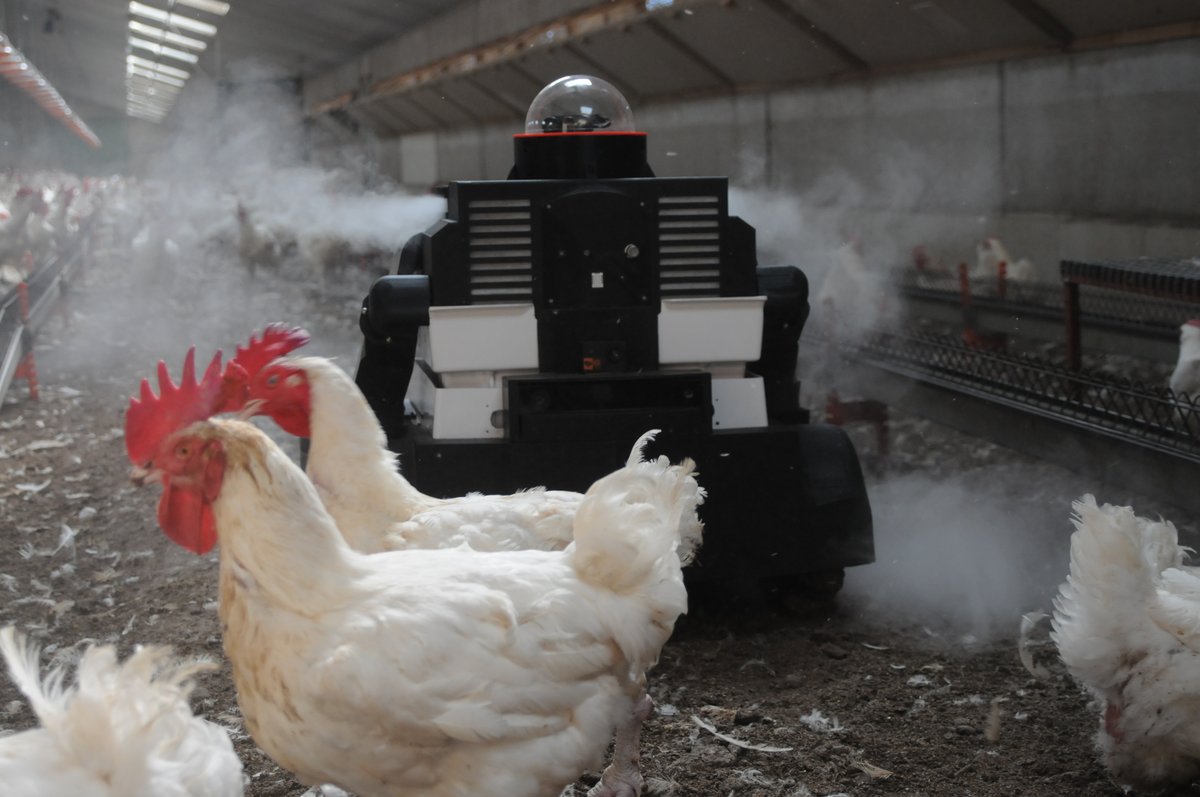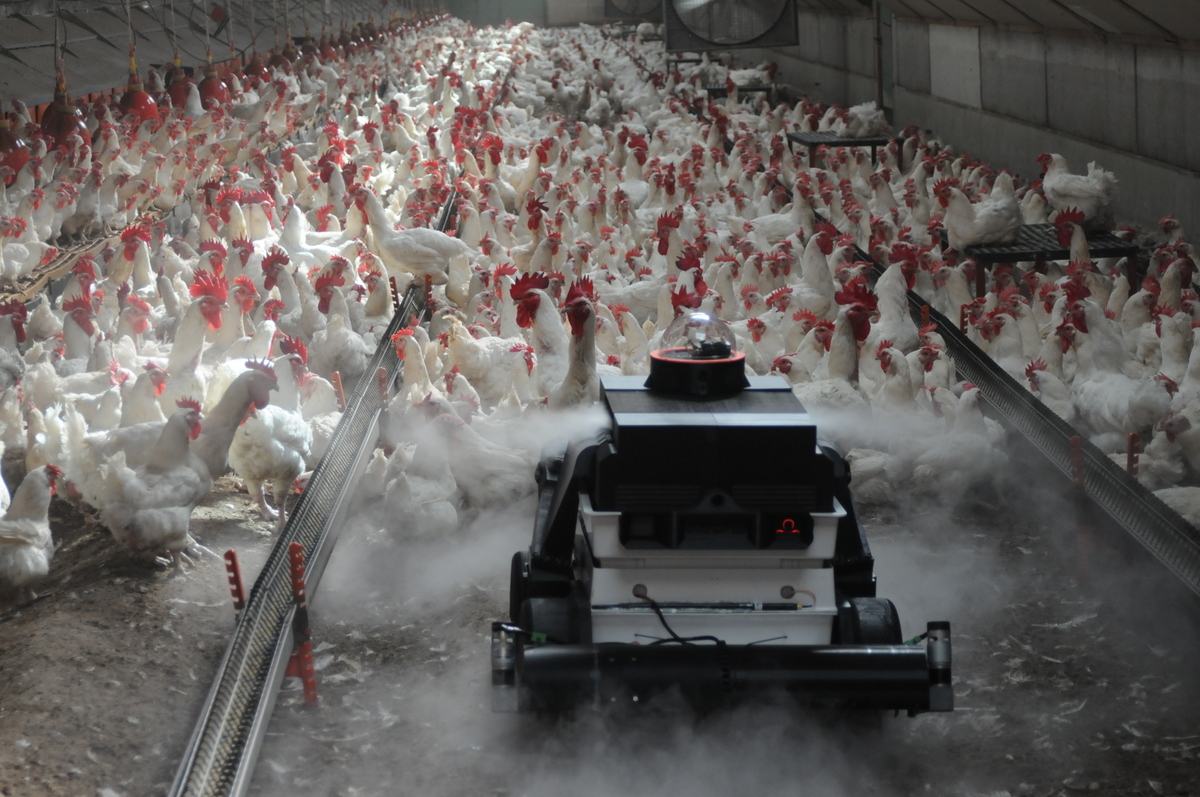



Robots: the new frontier in poultry production
While uptake is slow, robotics promises to improve poultry production efficiencies and ultimately boost food security.They might not be in line with our movie-informed ideas of what a robot should be like – such as Data in Star Trek or R2-D2 in Star Wars – but robots are playing an increasingly important role on poultry farms. By improving production efficiencies, they are boosting food security, improving animal health and welfare as well as contributing to better labour conditions and farm profits.
The French company Octopus Robots, last year launched two entirely autonomous robots. These bots very much resemble Hollywood’s animated rubbish-collecting bot Wall-E, as their primary functions, depending on the model, are either to clean and disinfect poultry houses or turn and aerate poultry bedding. But the bots are also modular – perhaps making them more like a Transformer – allowing users to turn them into several versions with the ability to perform different tasks.
Besides their primary functions, the robots are equipped to collect, analyse and store data – with sensors, cameras and other systems – through which they may help to improve record keeping and traceability on farms. The bots continuously measure environmental factors, such as temperatures, humidity, carbon dioxide and ammonia levels, alerting farmers in real-time of deviances and potential problems.
Frédéric Pradelle, chief marketing officer at Octopus Robots, says that robots are boosting biosecurity by performing tasks much more efficiently than would have been possible with manual interventions.
“Repeated avian flu outbreaks, the increase in zoonotic disease, the development of multi-drug-resistant organisms and the risk of bioterrorist attacks,” he says, “are harsh reminders of the crucial need to act quickly and effectively during a disease outbreak. By reducing human contact with birds, removing human error and doing tasks more efficiently, robots, such as ours, are becoming an invaluable tool in this on-going battle.”
Pradelle identified navigation as the biggest challenge in developing this type of technology: “You cannot use global positioning systems indoors, so we have had to develop a navigation system that combines the use of shape detection and recognition, triangulation and anti-collision systems, to mention only a few. Our technology is inspired by autonomous-vehicle technology.”
Other developments
Another company that has created a robot that will greatly improve efficiencies on poultry farms is Metabolic Robots. Their robot is similar to the fictional Hal 9000 from 2001: A Space Odyssey, in the sense that it is a smart computer that manages, measures, monitors and controls functions. Unlike Hal 9000, however, the robot can be switched off by the push of a button.
So how does the robot work? Ziv Dubinksy, CEO of Metabolic Robots, explains that the computer improves feed efficiency and, in effect, flock uniformity by taking over feed-line motors and adjusting the location and frequency of feedings: “The computer is installed on existing infrastructure,” he says. “It controls the feed motors via algorithms and uses sound and light effects to draw birds to empty feeders and drinkers.”

The technology is primarily aimed at the broiler market, as feed efficiency is higher in the layer industry and with mother flocks where timers are used to feed the birds two to three times a day. Dubinsky estimates that the feeding robot could reduce feeding costs by at least 5 percent, thanks to improved feed efficiency: “Total savings will be higher, as animals are generally more healthy, having access to feed when they want and need it.”
The system’s prototype was able to alert farmers of any trauma or pathogens that affect trackable feeding patterns in the flock and this feature has now been improved to suggest the type of infection, pathogen or trauma when the computer is connected to a broiler weight platform and a water-flow sensor.
“Farmers often recognise a health threat too late,” says Dubinsky, “so we have equipped our robot to not only give early warning of such threats but also to identify the specific threat or infection so farmers would know what remedy to use. At the moment, we are also working at combining an environment controller into the system to create a full barn robotic farmer, as well as a food-safety animal-welfare monitor.”
Various other robots have also become commercially available, ranging from bots that use artificial intelligence to debone a chicken in two to three seconds – almost like the Terminator might – and nanny bots that detect ill birds in flocks by monitoring temperatures and bird movements.
The future
The application of robotics in the poultry industry is nevertheless still in its early stages. “Like the automotive industry did over the past 20 years, the agriculture industry is currently achieving its own revolution by entering a new era of AgTech and Agbots,” says Pradelle.
Octopus Robots was launched in France and Italy last year, and plans to launch in the UK, Germany, the Netherlands, Latvia, Romania, Bulgaria, Poland and Russia within the next couple of months, and in the Middle East and Asia before the end of the year. The company is also seeking distributors in South Africa.
Plans are to branch out to the United States in 2019 to 2020: “We have to make the robots compliant with local regulations and are in the process of developing an advanced marketing plan for the States, through which we will cooperate closely with business partners and more specifically partners located in the major poultry producing states,” says Pradelle.
Market penetration is relatively slow, primarily because it takes time to develop, test and ensure the technology conforms to various standards set out by different countries, according to Dubinsky.
“Metabolic Robots was patented in 2009 and a prototype was developed in 2012. There are two operational beta versions running on two farms in Israel and long beta tests and data mining have been done in 12 locations across the world, including Ecuador, Estonia, Germany and Israel, with clients using internet-of-things blockchain technology to transmit data out of jungles and various other locations with no internet access,” he says.

While the Metabolic Robot is not yet used commercially, it has received international recognition for its ability to improve poultry-farm efficiency. According to findings presented at last year’s Poultry Science Conference held in Tel Aviv, birds in the beta tests performed much better than birds in control groups, with the feed conversion ratio being reduced by at least 4 percent in all locations.
The company has been awarded the EU’s Horizon 2020 programme’s “seal of excellence” and was a finalist in the global Nutreco Feed Tech Challenge. Dubinsky has also won Israel’s most prestigious award for technology – the Prime Minister’s Prize for Innovation – in 2014 because of his work’s social impact.
The company is currently taking orders from new clients and looking for partners, with a serial version planned to be launched by the end of 2018. It is also involved in two other projects: performing trials in the Netherlands with a novel non-invasive technology to determine the sex of unhatched eggs and the planning and construction of a next-generation insect-growing system.
Market penetration is slow because of a lack of incentives and regulations to promote automation in the industry, as well as the length of time it can take commercial farmers to acclimatise to new technology. “A pull is needed to get producers to adopt the technology faster; this will most probably come from insurance companies who see the potential of robotics in reducing farm risks,” says Dubinsky.
Pradelle identifies fear of change, and fear of robots in particular, as another obstacle. Dubinsky, however, feels that fear of the technology should not be a problem as most companies in the agricultural industry aim to make high-tech innovations as friendly as possible, so the systems are usually self-maintaining, relatively robust, plug-and-play, one-touch solutions. “Metabolic Robots will not break down,” says Dubinsky. “If any malfunction occurs, the barn will simply switch to non-robotic feeding like before installation.”
Pricing is not really an issue either, according to Dubinsky. He explains that the Metabolic Robot costs roughly US$3,000 per barn, but it has the ability to conservatively reduce production costs by $16,200 per broiler-house cycle. To justify the investment, the barn should ideally have three feed lines or more, with 20,000 to 60,000 birds per batch.
Both Pradelle and Dubinsky feel their robots do not threaten on-farm labour, but actually translate into better work conditions for their human co-workers, and will allow farmers and their staff to focus on more important matters.
This article was originally published in the March 2018 issue of our e-magazine, Poultry Digital








